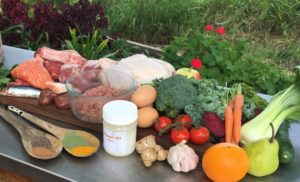
Over the millions of years that dogs have evolved from their wild wolf ancestors, their outward appearance may have changed, but their digestive system and the way food is utilised for growth, maintenance and reproduction is still 99% the same. Why then is it deemed that vegetables are good for dogs?
A study of foods eaten by wolves provides us with a good guideline for how we should be feeding our domestic dogs. A wolf diet would include, for example, small to large prey animals, reptiles, insects and fish as well as fruit.
Not only did the wolf eat a large variety of foods, it also consumed almost the entire carcass, which meant they ate everything from all possible bones, to the skin and organs. In smaller prey, the entire digestive system would likely be consumed and would contain pre-digested fruits and vegetables.
As such, mimicking this raw food diet in our domestic dog means vegetable matter can form part of the dietary mix. Given a dog falls somewhere in between being a carnivore and omnivore, fruits and vegetables are good for dogs, in appropriate amounts, and can provide a range of benefits in your dog’s diet.
Raw vegetables also provide your dog with a wide range of vitamins and minerals that can work alongside the amino acids and other nutrients found in meat and muscle meat.
Dark leafy green vegetables for example contain important minerals like calcium, potassium and magnesium as well as phytonutrients. Phytonutrients are only in vegetable material and are known to be antibacterial, anti-aging and cancer fighting.
They also contain enzymes that help in food digestion and absorption as well as antioxidants and fibre! Fibre is vital in older dogs in treating and preventing degenerative disease.
Whilst vegetables are good for dogs and can be extremely beneficial in appropriate portions, it should be remembered that dogs are not vegetarians so they can’t maintain health and vitality on vegetables and fruit only, ideally they should make up about 10% of your dog’s diet.
It should be noted that dogs can’t digest the cell wall (cellulose) in vegetable matter so if it is fed in chunks it can’t be digested so your dog will not receive the benefits. Ideally they should be raw and crushed, so either put through a juicer, blender or through a meat mincer and feed the pulp to your dog.
Use whatever vegetables are in season but avoid onions, grapes and raisins, and avocados, which can be toxic to dogs. Garlic does provide many benefits, but use only in moderation.
Avoid feeding too many vegetables in the cabbage family as they can depress the thyroid and avoid starchy vegetables like potatoes and tapioca.
Fruit must be fed ripe or it can cause diarrhoea.
Always speak to a Vet with raw nutrition experience before embarking on your own raw feeding diet or adding vegetables to your dog’s current diet.
To make it easier for you and safer for your dog, you may like to consider a raw food diet like Big Dog Pet Foods that has already been prepared in easy to use frozen packs to ensure your dog receives the right balance of fresh raw ingredients and nutrients.
A food science graduate, Chris Essex founded Big Dog Pet Foods in 2000 after many years working in the smallgoods industry, before he recognised a gap in the market to create pet food for dogs made up of bones and raw food that was full of nutritional ingredients. Visit www.bigdogpetfoods.com

Tips for preparing a raw food diet for your pet


Winter safety for dogs – Top Tips


Bladder Stones in Dogs and Cats


Get your paws on Lara Shannon’s best selling books ‘Eat, Play, Love (your dog) and World of Dogs.
Available in Australia, USA, UK and Canada.